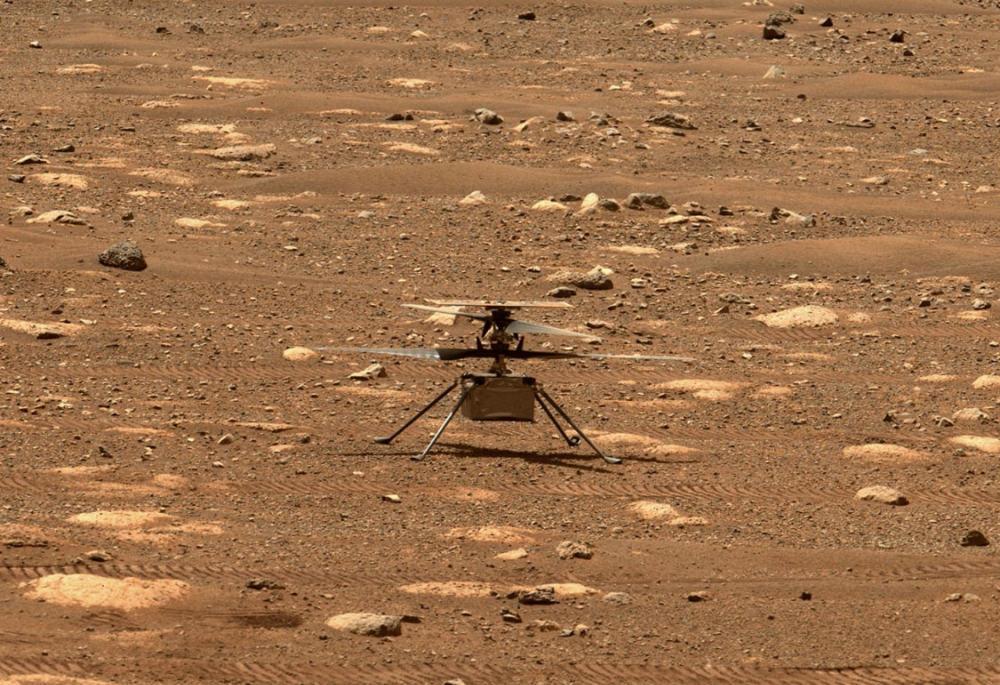Mars has been visited by several unmanned spacecraft. Mariner 4 was the first spacecraft to visit Mars; it was launched by NASA on November 28, 1964, and was closest to Mars on July 15, 1965. Mariner 4 detected a faint Martian radiation belt, measuring about 0.1 percent of Earth's radiation belt, and for the first time captured an image of another planet from deep space. [24] The latest successful mars spacecraft are the China National Space Administration's Tianwen-1 probe and Zhurong rover, which landed on May 14, 2021. [25] Zhu Rong was successfully deployed on May 22, 2021, making China the second country after the United States to successfully deploy a rover on Mars.

Flying a helicopter through an alien planet still looks like something in a sci-fi movie even in 2021. But that's not Ridley Scott's playbook, because NASA has already achieved its first controlled flight in another world. NASA's Dexterity Mars helicopter successfully completed its first test flight, marking a successful first test flight on another planet and a historic moment in space exploration. The custom helicopter stayed inside the belly of the Perseverance rover until it sailed to Mars and was carefully landed on the surface of the planet after successfully landing on the red planet on February 18, 2021.
The helicopter then completed several tests, including surviving the cold Martian night, unlocking light paddles and spinning at a certain speed. After a few days of delay in the technical glitch of the first flight test, the Dexterity was repaired and finally ready to take off, reaching a flight altitude of 3 meters or 10 feet in 30 seconds, circling in the air and taking aerial images of the surface of Mars, the sand it passed through, and the shadows skimmed by.
117 years ago, the famous Wright brothers achieved the first powered, maneuverable and sustained flight on Earth. Now, we have achieved the first powered, maneuverable, and sustained flight on Mars. Interestingly, under the Dexterity's solar panels is a small piece of parts from the wings of the original Wright Brothers aircraft. This low-altitude and short-lived first test flight may seem like a small step, but it is actually a huge leap for humans, because flying on Mars is no easy task.
The thin Martian atmosphere is only 1% thicker than Earth's sea level, which means that helicopters on Mars need to be completely differently designed. For example, the blades or rotors of the Dexterity are made of lightweight but durable carbon fiber, and they are particularly large in size compared to the fuselage, so they can obtain lift with the help of thin air.
The entire spacecraft is also very light, weighing only slightly more than 1.8 kilograms or 4 pounds, but even with such a weight, the rotation speed of the large blade is much faster than its speed on Earth, about 2000 revolutions per minute, so fast that it even begins to take the spacecraft off the ground. Another challenge the helicopter faces is the extremely cold temperature at night, which can drop below minus 83 degrees Celsius, or minus 117 degrees Fahrenheit, which means the Dexterity must have a small built-in heater to prevent its components from freezing.
Ground-fire distances add to the mission's challenge, as it currently takes 15 minutes for instructions from Mission Control to reach Mars, making it impossible to operate the helicopter in real time. However, Witty was given the ability to think autonomously, analyzing photographs taken from the air and looking for potential safe landing sites. This impressive helicopter is packed with complex devices that allow it to successfully fly on Mars.
Scientists say it is precisely because of the rapid advances in electronic technology over the past 15 years that this dream has come true. If all goes according to plan, the solar Mars helicopter will try to complete five missions in a month and challenge higher and farther flight targets. Sadly, however, after the test period, Witty will be grounded because its communication with Earth relies on Perseverance, which will focus on its exciting mission of finding signs of life on ancient Mars.
Related knowledge
Mars is the fourth-farthest planet from the Sun and the second smallest planet in the Solar System, only larger than Mercury. In English, Mars is named after the Roman god of war and is often referred to as the "red planet." [18] [19] The latter refers to the effects of iron oxide that are ubiquitous on the surface of Mars, which give Mars a reddish appearance (as shown), which is distinctive among objects visible to the naked eye. [20] Mars is an Earth-like planet with a thin atmosphere, with surface features reminiscent of the Moon's impact craters and earth's valleys, deserts, and polar ice sheets.
Because the rotation period and the tilt of the axis of rotation relative to the ecliptic plane are similar, the length and season of the sun on Mars are almost the same as those of Earth. Mount Olympus, the largest volcano in the solar system and the highest known mountain, is located on Mars, which is also home to Sailor Canyon, one of the largest canyons in the solar system. The smooth Burleris Basin in the Northern Hemisphere covers 40% of Mars' area and may be a feature of a large impact. [21] Mars has two small and irregularly shaped moons, Phobos and Phobos. They may be captured asteroids, similar to 5261 (Eureka), which belongs to the Trojan asteroid of Mars. [22] [23]
By:huangminxia, windy by the water